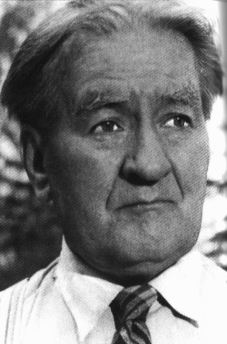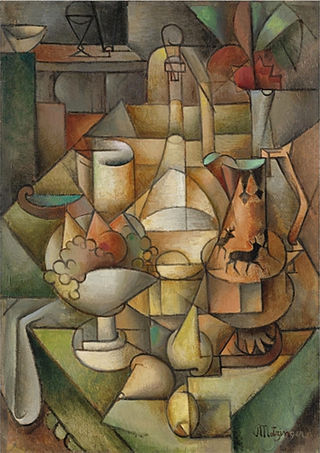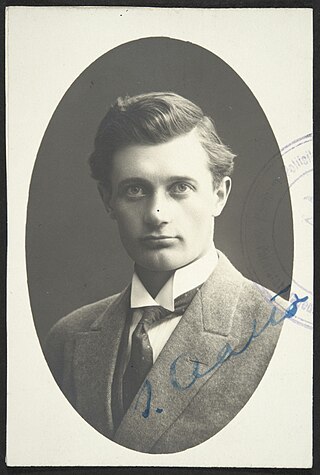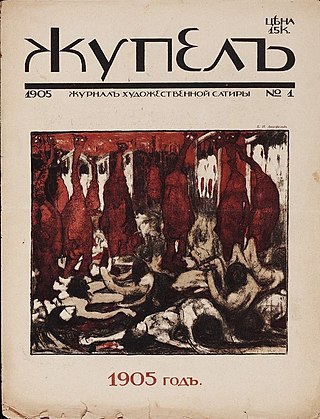Related Research Articles

In the arts and in literature, the term avant-garde identifies a genre of art, an experimental work of art, and the experimental artist who created the work of art, which usually is aesthetically innovative, whilst initially being ideologically unacceptable to the artistic establishment of the time. The military metaphor of an advance guard identifies the artists and writers whose innovations in style, form, and subject-matter challenge the artistic and aesthetic validity of the established forms of art and the literary traditions of their time; thus how the artists who created the anti-novel and Surrealism were ahead of their times.

Elmer Rafael Diktonius was a Finnish poet and composer, who wrote in both Swedish and in Finnish. In 1922 he established an avant-garde magazine, Ultra, which had Finnish and Swedish editions. He also involved in the establishment of another avant-garde magazine Quosego. He mainly lived in Tuomistonoja of the Röykkä village.
Jón Stefánsson (1881–1962) was Iceland's first modern landscape artists and one of the founders of modern art in Iceland.

Alli Hagar Olsson was a Swedish-speaking Finnish writer, literary critic, playwright and translator.

Nature morte, or Compotier et cruche décorée de cerfs, is a Cubist painting by the French artist Jean Metzinger. It was exhibited at Exposició d'Art Cubista, Galeries Dalmau, Barcelona, 20 April – 10 May 1912. During this show—the first exhibition of Cubism in Spain—Metzinger's painting became one of the preferred targets of the press. It was exhibited again 1 – 15 April 1917 at Nya Konstgalleriet founded by the Italian Futurist Arturo Ciacelli in Stockholm. Nya Konstgalleriet was one of the three main galleries in Sweden responsible for promoting national and international modernism between 1915 and 1925. The painting would eventually be exhibited at Galerie Philippe Reichenbach, Houston, where it was acquired in 1960. In 2008 Nature morte was auctioned at Sotheby's in New York.

Ilmari Aalto was a Finnish painter. He was a member of the expressionist November Group led by the artist Tyko Sallinen. Aalto painted still lives, landscapes and portraits.

Pia Arke was a Kalaaleq and Danish visual and performance artist, writer and photographer. She is remembered for her self-portraits and landscape photographs of Kalaallit Nunaat (Greenland), as well as for her paintings, writings which strove to make visible the colonial histories and complex ethnic and cultural relations between Denmark and Greenland. Throughout her artistic-research practice, the artist used the metaphor of her own mixed-heritage as an opportunity to engage these historical relationships, as well as address significant questions of Arctic Indigenous identity and representation.
Vindrosen was a Danish modernist cultural and literary magazine existed between 1954 and 1974. It was one of the Danish publications which improved the cultural journalism in the country.
Nuori Voima is a Finnish literary and cultural magazine which has been published since 1908. It is headquartered in Helsinki, Finland. Both the magazine and its parent organization, Nuoren Voiman Liitto, are among the well-respected institutions in Finland.
Axel Johannes Salto was a Danish ceramic artist of international fame. His works also include painting, graphic design and illustrations for books, jewelry and textiles. As author and founder of the art magazine Klingen (1917–1919), Salto was also an important contributor to the art debate in Denmark.

Per Bäckström is a Swedish literary scholar and affiliated professor in comparative literature at the Linnaeus University, Växjö, Sweden. He has worked as professor in comparative Literature, Karlstad University 2010–2019, and as associate professor at the Department of Culture and Literature, University of Tromsø, Norway 1996–2010. He took part in the founding of European Network for Avant-garde and Modernism Studies (EAM) in 2007, and was the leader of the Membership Commission 2007–2011. He has published studies on Bruno K. Öijer, Henri Michaux, Gunnar Ekelöf, Mikhail Bakhtin, intermediality, the grotesque, concrete poetry, performance, avant-garde and neo-avant-garde. He has made a critical reading of Michel Riffaterre's Semiotics of Poetry, where he introduces Riffaterre's theory, explains why it failed to make success, and criticizes it for its lack of consistency when it comes to experimental poetry. He has especially studied the use of the notions of “modernism” and “avant-garde” in Romance speaking languages versus English, and the role of the peripheries in relation to the supposed centres of the avant-garde in the 20th Century. He currently is working on the Swedish avant-gardist Öyvind Fahlström and The Anti-Aesthetics of Rock.
Kritisk Revy was a quarterly architecture magazine. It was briefly published between 1926 and 1928 in Copenhagen, Denmark. The magazine played a significant role in developing avant-garde culture in Scandinavia in the period between World War I and World War II. It is also the early source for the Danish modern.
The Máze Group was an art collective founded in 1978 in Máze, Norway, by the Sámi Dáidujoavku, which sought to define and carve out a space for Sámi identity and culture as part of contemporary art.
Byggekunst was a Norwegian language architecture magazine published between 1919 and 2007 in Oslo, Norway. The subtitle of the magazine was Norske arkitekters tidsskrift for arkitektur og anvendt kunst.
Taarnet was a monthly art and literary magazine founded and edited by Johannes Jørgensen in Copenhagen, Denmark. It was subtitled as Illustreret Tidsskrift for Kunst og Litteratur. The magazine was one of the early avant-garde publications and the major representative of symbolism in Denmark. It existed for one year between 1893 and 1894.

Zhupel was a Russian satirical magazine, founded by Zinovii Grzhebin in 1905. Among the contributors were the most famous Russian writers and artists of the time. Despite the success, like many other Russian satirical magazines, it was closed by the Tsarist government after publishing three issues, while Grzhebin was imprisoned. In 1906, the creators tried to revive the journal under the name Hell's Mail, but it was also closed after three issues.
Helhesten was an arts and literary magazine which was published between 1941 and 1944 in Copenhagen, Denmark. It was one of the leading publications during World War II in the region. Its title was a reference to a figure in the Norse mythology.
Ultra was an avant-garde bilingual art and literature magazine which appeared in Finland in 1922. Its subtitle was tidskrift för ny konst och litteratur. Although it produced only eight issues, it played a significant role in the introduction of avant-garde literary approach in the region.
Quosego was an avant-garde magazine which existed between 1928 and 1929 in Helsinki, Finland. Like its successor Ultra, it played a significant role in introducing the avant-garde movement to Scandinavian countries. The subtitle of Quosego was Tidskrift för ny generation. However, Quosego was much more inflential than its successor in terms of artistic and linguistic innovation.
References
- 1 2 3 4 Bjarne S. Bendtsen (2012). "Copenhagen Swordplay: Avant-Garde Manoeuvres and the Aesthetics of War in the Art Magazine Klingen (1917-1920)". In Hubert van den Berg; et al. (eds.). A Cultural History of the Avant-Garde in the Nordic Countries 1900-1925. Amsterdam; New York: Rodopi. pp. 391–400. doi:10.1163/9789401208918_026. ISBN 978-90-420-3620-8.
- 1 2 3 4 Bjarne S. Bendtsen (2013). "Copenhagen: From the Ivory Tower to Street Activism". In Peter Brooker; et al. (eds.). The Oxford Critical and Cultural History of Modernist Magazines: Europe 1880-1940. Vol. III. Oxford: Oxford University Press. p. 624. ISBN 978-0-19-965958-6.
- ↑ Benedikt Hjartarson (2006). "Dragging Nordic Horses past the Sludge of Extremes. The Beginnings of the Icelandic Avant-Garde". In Sascha Bru; Gunther Martens (eds.). The Invention of Politics in the European Avant-Garde (1906-1940) (19 ed.). Amsterdam; New York, NY: Rodopi. p. 244. doi:10.1163/9789401202527_014. ISBN 978-94-012-0252-7.
- ↑ Judith Gura (20 December 2014). "Mid-Century Innovator: Ceramicist Axel Salto Blended Form and Function". Blouinartinfo. Retrieved 29 May 2016.
- 1 2 3 Michael S. Byram (1973). The Novels of Tom Kristensen. Livets Arabesk, En Anden and Hærværk in their original context (PhD thesis). University of Cambridge. doi:10.17863/CAM.15906.
- ↑ Hubert van den Berg; Benedikt Hjartarson (2012). "Icelandic Artists in the Network of the European Avant Garde. The Cases of Jón Stefánsson and Finnur Jónsson". In Hubert van den Berg; et al. (eds.). A Cultural History of the Avant-Garde in the Nordic Countries 1900-1925. Amsterdam; New York: Rodopi. p. 233. ISBN 978-90-420-3620-8.
- ↑ Steen Klitgård Povlsen (2007). "Danish Modernism". In Astradur Eysteinsson; Vivian Liska (eds.). Modernism. Amsterdam; Philadelphia, PA: John Benjamins Publishing Company. p. 855. ISBN 978-90-272-9204-9.
- ↑ Kerry Greaves (March 2014). "Hell-Horse: Radical Art and Resistance in Nazi-Occupied Denmark". Oxford Art Journal. 37 (1): 51. doi:10.1093/oxartj/kct043.
- ↑ "Klingen, Volume 1". Archive.org. Retrieved 29 May 2016.
- ↑ "Title: Klingen". Princeton University Library. Retrieved 26 June 2021.